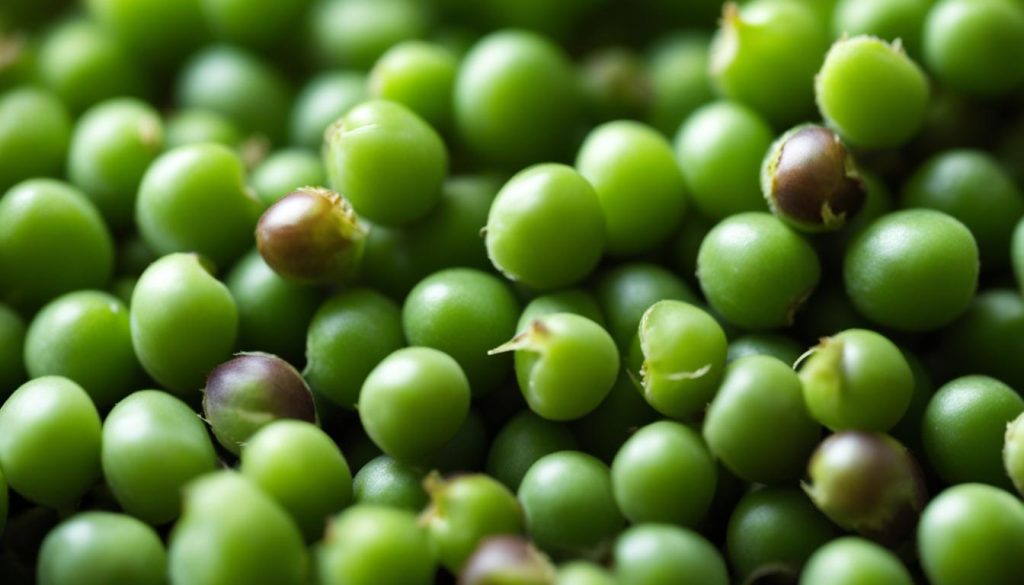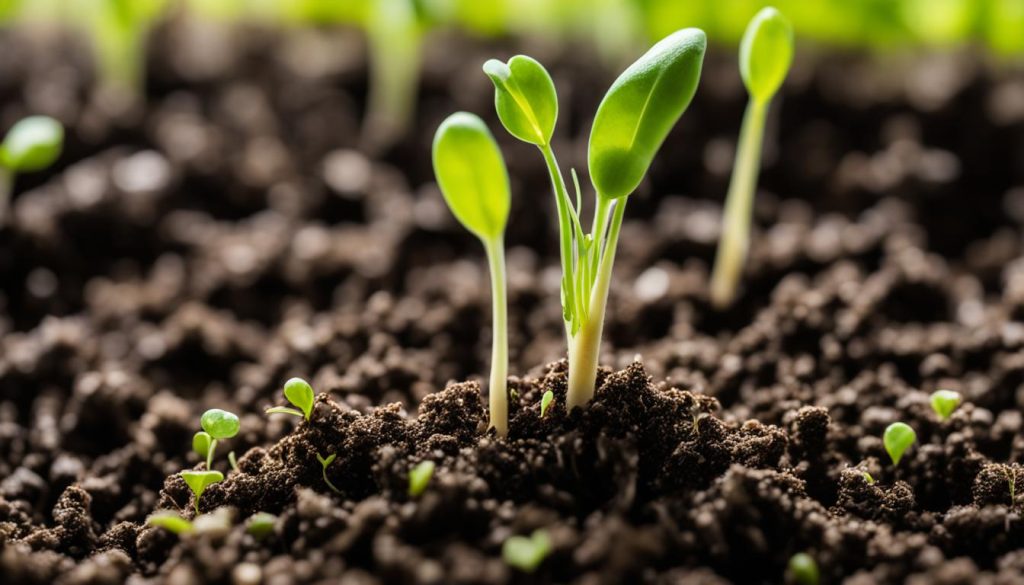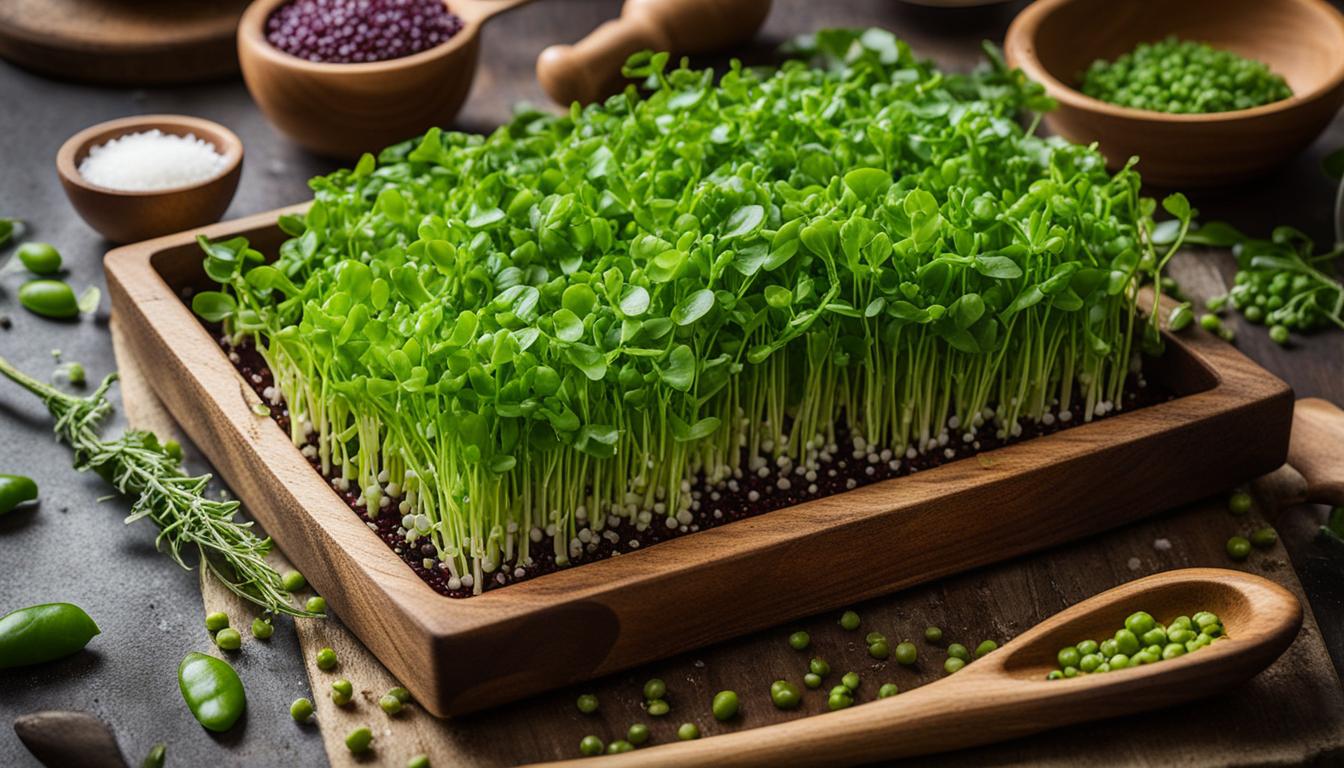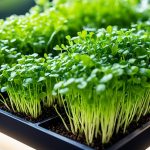Within the world of easy to grow microgreens, pea microgreens stand out as a delicious and nutritious option that can be nurtured right in the comfort of your home. These little greens are not only packed with health benefits but also bring a sense of gratification with their quick and simple cultivation process. Whether you’re a seasoned gardener or a curious beginner, growing pea microgreens at home invites a rewarding experience that turns your kitchen or balcony into a mini farm-to-table setup.
The journey from seed to sprout is a green thumb’s delight, and it’s especially appealing for those who want to boost their daily diet with something fresh. The sweetness and crunch of pea microgreens make them a standout addition to any meal, offering multiple pea microgreen benefits that rival their fully-grown plant counterparts. Piquing your curiosity yet? Let’s sow the seeds of know-how together and transform your greenscape with these sprightly sprouts.
The Nutritional Power of Pea Microgreens
Embark on a journey of discovery with the tiny yet mighty pea microgreens. These nutrient-rich microgreens not only add a dash of vibrant greenery to your plate but also deliver a host of health benefits that belie their diminutive size. A treasure trove of vitamins and minerals, pea microgreens bring much more to the table than their delicate texture and sweet flavor.
Vitamin and Mineral Richness
Dense with essential nutrients, fresh pea shoots and microgreens stand out for their impressive vitamin and mineral content. Consuming just a cup provides about 50% of the recommended daily intake of vitamin C, vital for a robust immune system. Alongside, they come packed with vitamin A for eye health, vitamin K to support bone strength, and minerals like iron and calcium that are crucial for overall well-being. It’s no wonder these greens are celebrated for their pea microgreen benefits.
Phytonutrient Content: Beta-Carotene and Lutein
These verdant shoots are more just than a source of essential vitamins and minerals; they contain a spectrum of phytonutrients like beta-carotene and lutein. Beta-carotene, the precursor to vitamin A, and lutein, renowned for its antioxidant properties, synergize to bolster your health, offering protection against cellular damage and nurturing cardiovascular health. Indeed, pea microgreens epitomize the concept of food as medicine, making every bite a step towards optimal health.
Gearing Up for Growing Pea Microgreens at Home
Embarking on the cultivation journey of easy to grow microgreens starts with a few essential steps to set your pea shoots up for success. With a little preparation and the right materials, you can harvest your own fresh pea shoots right from the comfort of your home. It all begins with selecting high-quality organic sproutable pea seeds and setting up the ideal growing environment.
Choosing the Right Pea Seeds
For flavorful and nutritious microgreens, starting with the best seeds is crucial. Sugar snap and snow peas are among the top choices for gardeners who enjoy sweet-tasting greens. Investing in organic sproutable pea seeds is highly recommended not only for the absence of synthetic pesticides but also to ensure the integrity of your crops from the start.
Soil vs. Grow Mats: Selecting the Ideal Medium
While some microgreen growers may use grow mats for certain varieties, pea microgreens thrive in a fine-textured, light seed soil or potting mix. This type of medium provides the support and aeration that pea seeds require to germinate and develop robust roots — a vital step for healthy growth.
Equipment Essentials: Trays and Lighting
When it comes to equipment, simplicity is key. Shallow growing trays paired with sufficient lighting will establish the perfect conditions for your pea microgreens. Whether you opt for natural sunlight or a grow light setup, ensure your sprouts receive plenty of light after the initial dark germination phase to flourish into lush, green leaves ready for your plate.

Starting Your Pea Microgreens: Soaking and Planting
Embarking on the adventure of growing pea microgreens involves a pivotal first step that sets the stage for the successful germination process. A fundamental task not to be overlooked is the pre-soaking of pea seeds—a process that initiates their growth journey. Let’s explore the impact of this crucial phase and share practical tips to sow your seeds effectively, paving the way for vibrant pea sprouts to thrive.
The Importance of Pre-Soaking Pea Seeds
Before nestling them into their soil beds, pea seeds benefit greatly when immersed in a cold bath. By soaking the seeds for 6 to 24 hours, you permit them to absorb essential moisture. This expansion is integral to kickstarting the germination process, ensuring your seeds are primed and ready to burst forth into growth. Soaking not only aids in growth but also dictates the seedling’s performance, ultimately influencing the robustness of your pea microgreens crop.

Sowing the Seeds: Techniques for Even Coverage
Once your seeds have absorbed water and increased in size, the next leap in growing pea microgreens is sowing them. A key technique for cultivating a lush blanket of greens lies in achieving even coverage. Carefully distribute the seeds across the growing medium, offering each seedling the room it needs to flourish, free from the competition that overcrowding brings. After ensuring each potential plant is ideally placed, a gentle cover of soil creates a dark and cozy environment for sprouting—a nest that protects the seeds from light, yet welcomes their eager roots.
With these steps faithfully followed, you’ll find yourself on the verge of witnessing the magic of lush pea sprouts gracing your home garden, narrating a tale of tiny but mighty growth. The pursuit of nurturing pea microgreens offers not just nourishment, but a dance with nature’s persistent rhythm of life—a journey well worth embarking on.
Pea Microgreens: The Unfolding Growth Process
Embarking on the journey of cultivating your own easy to grow microgreens, such as pea microgreens, is not only gratifying but is also a step towards embracing a diet filled with nutrient-rich microgreens. The post-sowing phase is crucial and requires careful attention to set the stage for optimal growth. A controlled environment that caters to the necessity of darkness and consistent moisture sets the foundation for robust sprouts.
Creating the Right Environment: Darkness and Moisture
To kickstart the germination process, the newfound pea seeds demand an environment shrouded in darkness. This simulative mimicry of being buried under soil, coupled with adequate moisture, sends a signal to the seeds triggering their transformation. Those first few days are a delicate period, where the seeds swell and start pushing out their initial roots.
The Transition to Light: Where and How to Position Your Sprouts
The shift from darkness to light is a pivotal moment in the pea microgreens growing guide. After approximately three to four days in their dark cocoon, the sprouts are ready for their first encounter with light. This exposure is not merely a change in scenery; it activates chlorophyll production, giving the sprouts their characteristic vibrant green hue, signifying health and vitality. The positioning of your greens after this transition directly influences their growth, with careful placement ensuring even light distribution necessary for balanced growth.

Navigating Your Way Through Germination to Greening
Embarking on the journey of growing pea microgreens at home is an exciting venture for garden enthusiasts and health-conscious individuals alike. The secret to nurturing these delicate greens lies in understanding their needs during the crucial stages of the germination process. Patience coupled with careful observation can yield a lush spread of sweet and tender pea sprouts.
From Germination to First Sprouts: What to Expect
After planting the pre-soaked seeds, the magic of germination begins with the first root, known as the radicle, pushing through the seed coat. With consistent moisture, but not excess water, and the warm embrace of darkness, your seeds will efficiently embark on their transformative journey. Generally ranging from 3 to 5 days, this period will showcase the emergence of young plants that will soon crave the sun’s energy. Expect to see these pea sprouts as tender shoots, an announcement that the next phase of their growth is ready to unfold.
Introducing Light and Managing Water for Thriving Pea Microgreens
With the arrival of the sprouts, it’s now time to unveil their world to light. This exhilarating transition calls for at least 12 hours of sunlight or equivalent grow light per day to champion photosynthesis, driving the development of vibrant, green leaves. The art of watering becomes even more nuanced; a gentle touch from below ensures that the pea microgreens receive ample moisture without compromising the integrity of their stems and foliage. As you nurture these sprouts with light and water, you are not merely watering plants but cultivating life, eagerly anticipating the lush greening that signifies a successful harvest ahead.
Pea Microgreens
As urban gardening gains momentum, pea microgreens have surged in popularity, not just for their ease of cultivation but also for their notable health benefits. These tiny yet mighty greens represent a symphony of vitamins and minerals that can elevate your daily nutrition. Ensuring that your little garden thrives involves understanding the perfect time for harvesting pea shoots and how to encourage pea sprouts to yield the richest flavors.
The Journey to Harvest: Recognizing Maturity in Your Greens
The secret to harvesting the most flavorful and nutritious pea microgreens lies in timing. Monitoring your greens closely, you’ll find that as they reach the 3 to 5-day mark post-sprouting, achieving a height of 3-4 inches, they are ready for harvest. This stage ensures that you’re getting the full spectrum of pea microgreen benefits. Perfection is found in their tender leaves and slightly crunchy stems—all hinting at maturity.
Achieving Multiple Harvests: Understanding Pea Growth Cycles
Unique among microgreens, peas offer the potential for multiple harvests, enabling gardeners to get more from their crops. By opting not to harvest immediately but to instead allow the pea sprouts to continue growing into shoots, it is possible to extend the harvest period. These shoots need several days more to develop their distinguishing tendrils and mature leaves. With patience, your pea greens can give you not just a bountiful first harvest but also a rewarding second round.
Harvesting Your Fresh Pea Shoots
The moment of harvesting pea shoots is just as rewarding as watching them grow. It’s when you get to reap the fruits of your labor, filled with the promising flavor and pea microgreen benefits you’ve nurtured from seedlings. Knowing when and how to harvest can make all the difference in ensuring that your fresh pea shoots deliver the utmost in terms of taste and nutritional value.
Signs Your Pea Microgreens Are Ready for Harvest
Gauging the perfect time for harvesting pea shoots is not complicated. You’ll notice that the microgreens have grown to their ideal height, usually around two to three inches, and the cotyledons are fully developed. These are the first set of leaves that the plants sprout, and they indicate that your greens have reached maturity and are packed with flavor.
Best Practices for Harvesting: Techniques for Freshness and Flavor
To collect your bounty, use a pair of clean, sharp shears to snip the greens just above the soil. This method helps to preserve the integrity of the plant and reduces any potential for bruising. If you’re aiming for pea shoots, be sure to leave behind some leaves on the stem; this encourages the plant to regrow, providing you with a sustainable harvest. An excellent tip for maintaining that fresh pea shoot zest is to wash them right before use rather than immediately after harvesting. Store them unwashed in an airtight container with a paper towel to extend freshness. These practices ensure you enjoy the full spectrum of pea microgreen benefits, from nutrition to taste.
Integrating Pea Microgreens Into Your Diet
Rich in flavors and packed with nutrients, pea microgreens are a versatile ingredient that can be utilized in a myriad of dishes. From novice cooks to seasoned chefs, the culinary uses of pea microgreens are limited only by one’s imagination. These nutrient-rich microgreens are not only a vibrant addition to the plate but also an explosion of vitamins and minerals in every bite.
Innovative Culinary Uses: From Salads to Sandwiches
Experimenting in the kitchen with fresh pea shoots adds a dash of creativity to ordinary dishes. Whether tossed into a refreshing summer salad for a nutritious lunch or layered within a hearty sandwich for added texture and taste, pea sprouts adapt beautifully to an array of recipes. They can be sprinkled atop soups as a garnish or even blended into smoothies for a green nutrition boost.
Keeping It Fresh: Storing Your Pea Microgreens for Longevity
Maintaining the freshness of these greens is key to enjoying their benefits for as long as possible. Proper storage involves placing them in a clean container lined with paper towels, which absorb excess moisture, and then refrigerating to slow down the degeneration process. When stored correctly, pea microgreens can stay crisp and delightful for a week or more, ready to enhance your next culinary creation.
Overcoming Common Growing Challenges with Pea Microgreens
When cultivating pea microgreens, even the most vigilant growers may encounter obstacles that can affect plant health and yield. Armed with the right knowledge and techniques, however, these common issues can be addressed, ensuring your green endeavors thrive. From moisture management to lighting considerations, let’s explore strategies to help your pea sprouts flourish undeterred by potential growing pains.
Preventing Mold and Rot in Your Microgreen Crops
Mold and rot can swiftly derail your aspirations of growing lush pea microgreens. The culprits tend to be excessive moisture and poor air circulation. Tackling this requires a balance in watering practices and the use of properly draining soil. Reducing ambient humidity and improving air flow are also essential in creating an environment hostile to mold. Frequent checks can help spot issues early, and actions taken swiftly can prevent them spreading to your crop of microgreen vegetables.
Dealing with Leggy Shoots: Ensuring Adequate Lighting
Leggy shoots often signal a plea for more light. Ensuring that each pea sprout receives equal and ample brightness can thwart their elongated stretch toward the light source. Adequate lighting encourages stout, sturdy growth, giving the microgreens the energy they need for photosynthesis without necessitating a wild search for the sun. Utilize a blend of natural light when available and supplement with grow lights if necessary. It’s this precise calibration of conditions that solidifies your role as an adept cultivator, guided by a reliable pea microgreens growing guide.


